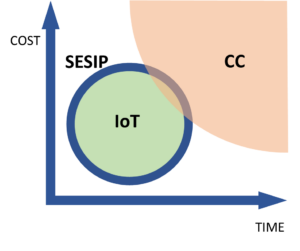Securing the IoT: SESIP or Common Criteria? That is not the question
There has long been a debate among the security community about the commonalities and differences between the Security Evaluation Standard for IoT Platforms (SESIP) and Common Criteria (CC). However, which is the correct methodology to use for IoT developers and device makers when securing the IoT ecosystem? Carlos Serratos, IoT Certification Expert at NXP, enters into the discussion…
Since the introduction of SESIP, there have been some recurrent questions. One of those revolves around the relationship with Common Criteria. That is because, in reality, SESIP fills a gap in the security evaluation space, coexisting side by side with Common Criteria in a harmonious, complementary way. While this is easy to say, it is worth exploring and addressing some of the misunderstandings along the way.
The origins of Common Criteria
Before the SESIP methodology was established, there was the standard ISO/IEC 15408 which is often referred to as Common Criteria or ‘CC’. It is the most recognized and mature standard for qualifying the risk introduced by IT equipment.
First established as a methodology for IT procurement of public entities, Common Criteria has become a reference in the industry – one which has been used in public and private sectors and addresses a large list of IT product types. However, the strength of Common Criteria, in terms of being a generic evaluation program, has become something of a ‘liability’ in the IoT domain. That is because, while IoT product time-to-market and cost sensitivities are key drivers, Common Criteria lives on the opposite corner of the chart (see Figure 1 below).

Figure 1. The relative position of Common Criteria (CC) versus the market needs of the IoT domain
The origins of SESIP
It is here where SESIP comes into the picture and offers a viable alternative. Addressing the IoT market with a methodology optimized for IoT components and platforms, SESIP takes best practices and lessons learned from the Common Criteria experience.
And so, here lies the first difference but also the complementary nature of the two standards: while Common Criteria can also be used for IoT platforms – since it is made for all kinds of IT equipment – it results in evaluations with a cost and effort unaligned with the IoT market expectations. Meanwhile, SESIP addresses it by applying best practices from Common Criteria, and security evaluation in general, in a custom-built manner for IoT.
Common Criteria's approach to composition is from a general-purpose methodology perspective. It adds a level of complexity, and this problem is inherent to any ‘general’ solution in a world with a variety of scenarios. In comparison, SESIP focuses solely on IoT components and platforms.
What the audience requires from Common Criteria and SESIP
Due to historical reasons, Common Criteria addresses the evaluators and certifiers as the prime audience. It is oriented to a very specialized audience who have specific skills and knowledge (especially as Common Criteria is not easy to read), and the objective does not address the needs of developers. After all, the standard was created as an audit tool for the procurement of IT equipment.
In that regard, SESIP instead looks to address the developer's needs. It aims for simplicity, clear understanding, and transparency and is designed to be understood by a non-specialized audience. For example, there might be a developer of a TLS stack looking to use an RTOS from another developer who is using a crypto library from another developer that relies on the random number generation of a chip. And although each professional has a different requirement, all of them will be using SESIP.
For that reason, the SESIP methodology requirements for the documentation, presentation of the evaluation results, and all related evaluation information are accessible, readable, and understandable by an audience made up of developers rather than evaluation and certification specialists, as is the case of Common Criteria.
Ultimately, SESIP is a tool for developers to select the right platforms and components to apply State-Of-The-Art technology according to their use cases, as we explored in a previous blog. The methodology is looking to solve a problem beyond security functionality and visibility, instead exploring fragmentation as there are hundreds of standards, policies, and regulations worldwide for the IoT.
Evidence from SESIP-certified components and platforms serve as evidence of the conformance for the device security functionality that can be mapped in the consumer (EN 303645, NIST 8259a, NIST 8425), industrial (IEC62443-4-2), medtech (DTSeC), and automotive markets (ISO21434).
The overall differences at-a-glance

In summary, a SESIP evaluation is never the end of the road, it is often the start of the security journey. The Common Criteria and SESIP standards are particularly good at something, and one will be the strong option over the other for a particular application and domain. In truth, that is a great place to be for security and standards because, by having similar origins, they are both complementary in nature.
Watch Carlos discuss quantifying the benefits of SESIP. And for more information about GlobalPlatform and how to contribute to shaping the future of IoT security, visit the membership page.

